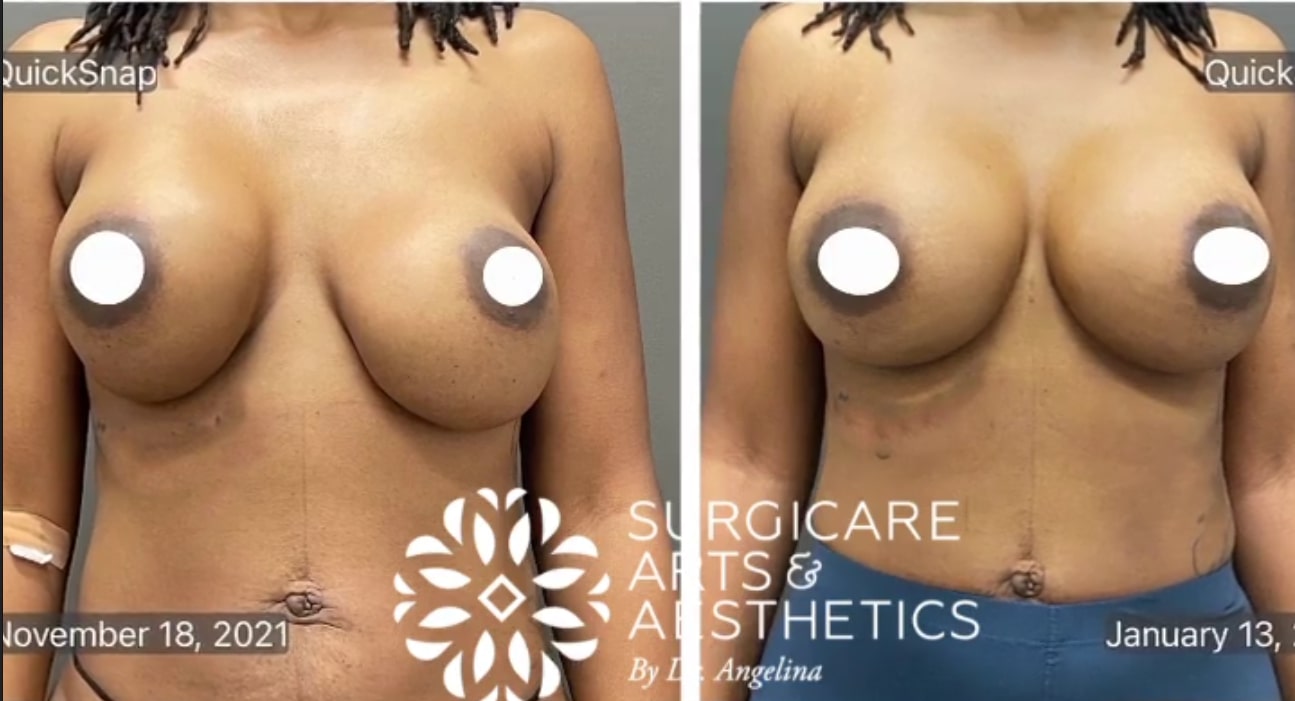What Can Cause The Displacement Of Breast Implants And Can It Be Fixed?
After breast augmentation with implants, it is normal to experience some “settling”. This process can take a few months as the breast implants settle into their respective positions and conform to their intended form. This is also sometimes called “dropping and fluffing” because the volume will settle at the lower portion of the breast implant and look like natural breast tissue.
Most women who have breast implants never have any issues but sometimes, the breast implants may shift causing the breasts to look abnormal. This is known as breast implant displacement and can happen for a number of reasons.
Today we are going to answer some of the most-asked questions about breast implant displacement and how to fix breast implant displacement.
What Can Cause Breast Implant Displacement?
Breast implants can move from their intended location or become displaced due to capsular contracture, anatomical anomalies present in the patients before the implants were installed, surgical technique, or gravity with larger breast implants.
Regardless of the cause, each different type of implant displacement will most likely present with noticeable aesthetic markers and breast implant displacement symptoms may also include pain or discomfort.
Some Tell-Tale Signs That Indicate Your Implants May Migrate
- The breasts feel different to the touch or visually look different;
- Your breasts are no longer symmetrical and do not match;
- When wearing a bra or bikini, you nipples are popping out of the top;
- You are experiencing breast discomfort standing up or lying down.
What Types Of Implant Displacement Could I Experience?
The following is a list that describes the different types of breast implant displacement patients can experience.
- 1. Bottoming Out
- When implants “bottom out”, it means that they have dropped below the inframammary crease. This is the crease just under the breast. This can cause a bulge to form at the bottom of the breast or can make the nipple unnaturally point upward.
Bottomed-out implant revision before and after - 2. Implants That Are High Riding
- This condition is the opposite of bottoming out and happens when the implants are positioned high on the breasts and exert pressure on the tissue underneath the implants. High-riding implants can not accurately be diagnosed until after the new breast implants have been through their normal “settling” time frame of around 4 to 6 months.
- 3. Lateral Displacement of Breast Implants
- This condition occurs when too much breast fullness falls to the side and in advanced cases can have women complaining that their breasts are in their armpits. Lateral displacement of breast implants is most often caused by surgical error and can be exacerbated by the natural action of the muscle gradually pushing the implant over to the side.
Sometimes lateral displacement of the breast implants is not noticed unless a woman is reclining and then her breast (s) will fall over to the side. The breasts will appear unnaturally far apart and may present little or no cleavage.
- 4. Symmastia
- This condition is not common but can occur if the skin and muscle above the sternum and between the breasts detach. This can cause the pockets where the implants were installed to join together and create one bigger pocket resulting in a “uni-boob”.
The surgeon has to manually create a pocket in the breast to hold an implant because there is not one that occurs naturally. Sometimes symmastia is a congenital condition and other times it may be a result of an accidental surgical cut during the implant process.
How Do They Fix the Displacement of Breast Implants?
A cosmetic surgeon can correct implant displacement during a breast implant revision surgery. The technique used to fix breast implant displacement varies depending on the cause of breast implant migration.
One method used to fix the lateral displacement of a breast implant is to create an incision along the line of the previous scar and perform a breast capsulorrhaphy. This procedure is done to tighten the capsule pocket and reshape or reposition it to a place that has more support. This is often done with sutures and sometimes with a reinforcing mesh material.
During the procedure, the edge of the breast pocket is often reattached to the chest wall and some of the pockets is closed off. The mesh that is used to reinforce the area will be replaced by a layer of tissue created by the body as part of the natural healing process that will reduce the risk of another failure.
Implants that are placed over the muscle are more at risk of “bottoming out” because the only form of support is the tissue and skin. The risk is greater the larger and heavier the implant.
You can help mitigate the risks of bottoming out if after your implant surgery and during your healing process, you wear a support bra continuously for at least a year. This will help natural scar tissue to form which will act as an internal support system for the breast implants.
One technique surgeons use to correct bottomed-out implants is an internal surgical bra. This “bra” is created using sutures along the inframammary fold to help adhere the implant in place or the surgeon may also choose to use a reinforcing mesh.
What Are Breast Implant Displacement Exercises?
In most cases, after having breast implants the surgeon will provide the patient with aftercare instructions. This will be a document of detailed information on how to care for themselves to ensure a complication-free and swift recovery. If round smooth implants have been used, these aftercare instructions may include exercises that are intended to prevent capsular contracture.
Immediately after breast implant surgery, the body will begin reacting to the foreign object that has been placed inside and begins forming a capsule around the breast implant. In some cases, this capsule may begin to contract and form excessive scar tissue. This can cause hardened painful areas around the breast and can displace the implant giving the breast an unnatural appearance.
Breast implant displacement exercises help stretch areas including the internal incision scar to keep the areas pliable, soft, and positioned correctly. The patient is lying down or reclining during the exercises to eliminate the force of gravity. It is important to follow the surgeon’s directions when performing these exercises to ensure they are done correctly.
If performed incorrectly, breast implant displacement exercises can do more harm than good.
Does Breast Implant Displacement Cause Pain?
Yes, some types of implant displacement can be painful or uncomfortable. When scar tissue forms around an implant and begins to push it out of place this can cause breasts to be tender and painful to the touch.
Patients who experience symmastia often have pain, discomfort, and visibly distorted breasts.
Breast implant displacement almost always presents with a noticeable abnormality of the breast.
If you are concerned that you may be experiencing breast implant displacement, contact IBI Plastic Surgery & Med Spa today. During your consultation, Dr. Angelina Posteov, a triple-board certified cosmetic surgeon can discuss the best plan of care to correct whichever type of displacement is occurring.
To learn more about breast enhancement procedures, set up your consultation today!







